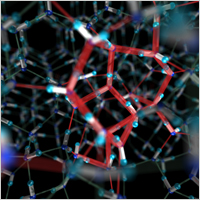Enlarge Image
Theoretical physics: Demystifying the molecular mechanisms of the initial stages of how ice melts
In general, the surface of ice acts to initiate melting and therefore ice melts starting from its surface at 0 degrees Celsius—a process referred to as heterogeneous melting. On the other hand, in the absence of a surface, an ideal melting process would occur from inside ice. In this case, where ice spontaneously loses its structural order due to thermal agitations, the process is termed homogeneous melting.
Homogeneous melting is one of the most important processes in physics and chemistry and is known as a first order phase transition. Probing the mechanism by which water molecules introduce disorder spontaneously which leads to melting is a major challenge.
Now, the research team of Okayama University simulated the melting process of ice using a computational technique called molecular dynamics. Importantly, they introduced a new measure for the disorder in the structure of ice, and examined the complete mechanisms of melting starting with the emergence of disorder to the growth of a molten droplet and finally the total collapse of ice. They found that the melting process of ice is not a simple process with the emergence and subsequent growth of a disordered embryo but instead an entangled process triggered by the separation of pair defects.
Hydrogen bonds strongly bind water molecules in ice. Therefore, even if the ice structure is partially broken by thermal fluctuations, it recovers its order in a short period of time. However, once a pair defect is generated and separated, random motion of the defects prevents it from reuniting by going back to the correct return paths. Pair defects also work as catalysts to accelerate structural changes in ice, thereby leading ice to melt.
These findings are valuable insights into the structural changes in many other materials including biomolecules, and in the future may lead to unraveling the 'mechanism of life'.
Reference:
・ Authors: Kenji Mochizuki1, Masakazu Matsumoto2, and Iwao Ohmine3
・ Title of the original paper: Defect separation as the controlling step in homogeneous ice melting
・ Journal, volume, pages, and year: Nature, 498, 350–354 (2013) (Cover Article)
・ Digital Object Identifier (DOI): 10.1038/nature12190
・ Affiliations:
1: School of Physical Sciences, The Graduate University for Advanced Studies (SOKENDAI), Myodaiji, Okazaki 444-8585, Japan
2: Graduate School of Natural Science and Technology, Okayama University, 3-1-1 Tsushima, Okayama 700-8530, Japan
3: Institute for Molecular Science, Myodaiji, Okazaki 444-8585, Japan
Author website(Japanese): http://theochem.chem.okayama-u.ac.jp/wiki/wiki.cgi/matto

